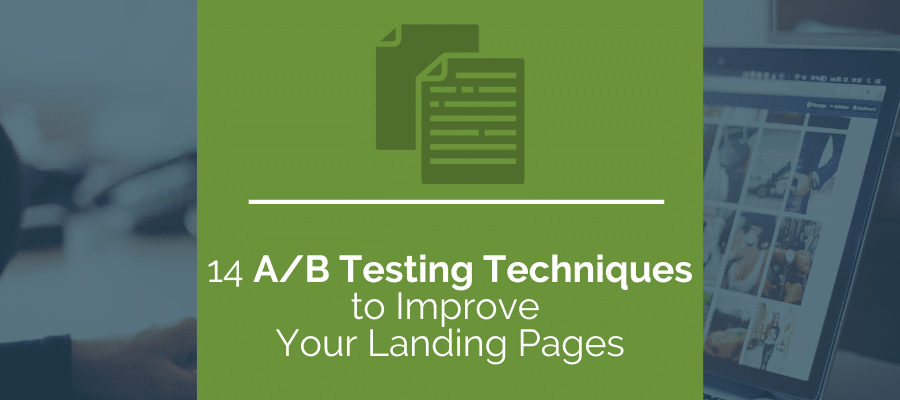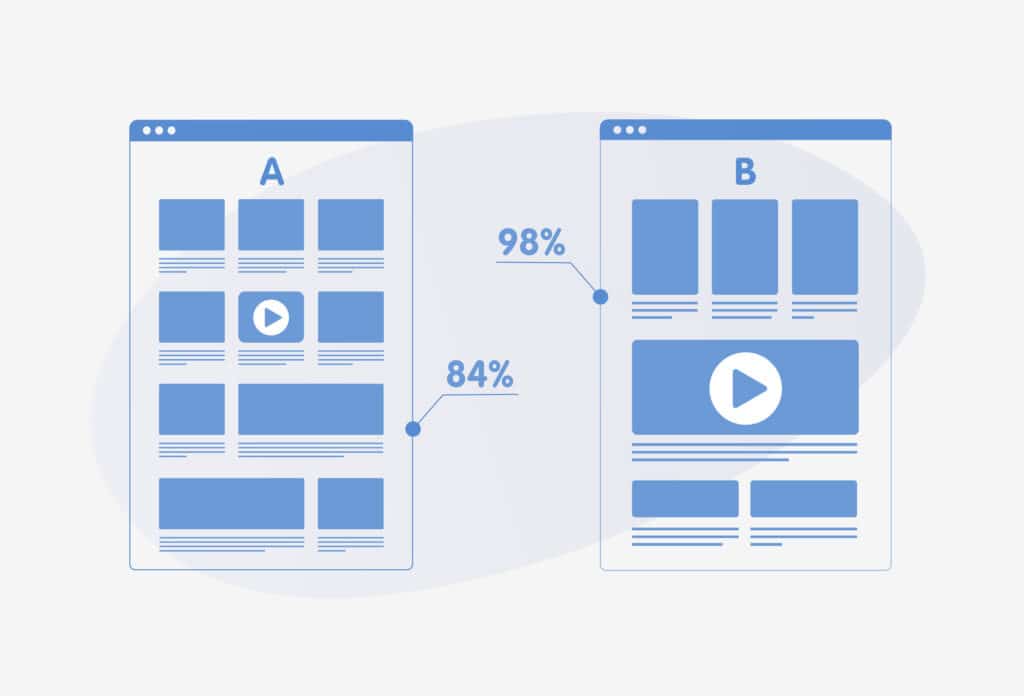
Your landing page is often the first page that potential customers see. It’s the first impression that can make or break a conversion. If you want to ensure that your landing page is maximizing its potential, A/B testing is the key. In this guide, we’ll explore A/B testing techniques that will help you fine-tune your landing page for ultimate success.
What Is A/B Testing?

The right A/B testing techniques can help you reach more customers and increase conversions.
A/B testing is a method that allows you to compare two versions of a web page to determine which one performs better. It’s a controlled experiment where you present two variations (A and B) to different segments of your audience and measure which one yields the desired action, such as signing up, making a purchase, or filling out a contact form.
Why A/B Testing Matters for Landing Pages
Your landing page may seem perfectly designed, but user behavior can be unpredictable. A/B testing allows you to remove the guesswork and make data-driven decisions to optimize your landing page’s performance. Here’s why it matters:
1. Improves Conversion Rates: A/B testing identifies what resonates with your audience, helping you make changes that lead to higher conversion rates.
2. Reduces Bounce Rates: By testing and refining elements on your landing page, you can minimize bounce rates and keep visitors engaged. Lower bounce rates not only helps to improve engagement, but also improves SEO.
3. Enhances User Experience: Understanding what works best for your audience ensures a smoother and more satisfying user experience.
4. Boosts ROI: A/B testing can lead to increased conversion rates, which ultimately boosts your return on investment (ROI).
Now, let’s dive into effective A/B testing techniques for your landing page.
14 A/B Testing Techniques to Improve Your Landing Pages
These A/B testing techniques can help improve your landing page. It’s important to approach each of these techniques in a methodical way, one at a time. Testing too many elements at one time will make it difficult to confirm what’s working and what isn’t.
1. Headlines and Copy
The headline is the first thing visitors see, so it’s a critical element to test. Try different headlines and copy variations to see which one resonates better with your audience. Experiment with tone, length, and messaging to find the sweet spot. Remember to use an active voice to capture your audience’s attention, and keep it clear and concise.
2. Call-to-Action (CTA) Buttons
Call-to-action buttons play an important role in the conversion process, and even small changes can make a big difference. Consider changing the color, size, text, and placement of your CTA buttons. Test different CTA button designs to determine which one prompts the most clicks.
3. Images and Media

Highlighting video and other media elements can make your landing page more impactful for many customers.
Images and videos can influence engagement significantly. Test various visual elements to see which ones capture your audience’s attention and lead to longer page visits. For example, video demonstrations can be helpful to show your customers how a product works.
4. Forms
If your landing page includes a form, test its length, fields, and placement. This is one of the most common A/B testing techniques, and it can make a significant impact on the page. Reducing friction in form completion can lead to more submissions. However, this can be a balance between getting the information you need and making it easy to fill out the form. Consider which form fields you really need, and what information you could acquire later.
5. Page Layout
Experiment with the overall layout of your landing page. Adjust the arrangement of elements, the navigation menu, and the use of white space to optimize the user flow. Your audience may respond better to certain elements, and they may respond better to the page overall when these elements have primary placement. In other cases, removing some elements and using white space can make the page easier to read. Experimenting with different arrangements can help you find the best layout.
6. Trust Signals
Trust signals such as customer testimonials, trust badges, and security icons can boost credibility. Test different trust signals to see which ones have the most impact. For example, video testimonials can have significant benefits when it comes to overcoming customers’ doubts or uncertainties, and improving conversions.
7. Page Load Times
The speed at which your page loads can affect bounce rates and conversions significantly. Generally, web visitors won’t wait around more than a couple seconds for a page to load. This sometimes means removing elements that take longer to load. Test different page load times to find the optimal balance between performance and visual elements. Compress and optimize images, where possible, to add visual elements without adding load time. If you’re not sure what’s slowing down your page, a tool like Google’s PageSpeed Insights can help.
8. Mobile Optimization
Today, users make more searches and browse sites on their mobile devices more than their laptops or desktop computers. If your page isn’t optimized for mobile devices, it can seriously affect your traffic. Ensure that your landing page is mobile-responsive and test different mobile layouts to accommodate a diverse range of devices and screen sizes.
Fine-Tuning Your A/B Testing
In the previous section, we covered A/B testing techniques that affect which elements of the page to test. Let’s continue the list with a few tips to improve your A/B testing techniques.
9. Test One Variable at a Time

Testing one change at a time can help you hone in on what works best.
Test one element—for example, only the heading or only the chief image—at a time to isolate its impact. Though it can be time-consuming, this will allow you to see whether or not each change yields the result that you want.
10. Define Clear Goals
Without clear goals, it’s hard to know if your A/B testing strategies are actually going in the right direction. Establish clear, measurable goals for your A/B tests, such as increasing sign-ups by 10%, or improving traffic by 20%.
11. Monitor Traffic and Sample Size
Ensure you have a sufficient sample size and a steady flow of traffic to generate meaningful results. If your landing page appeals to a narrow audience within a specific industry, this can be challenging, and you may need to extend your testing time period longer.
12. Be Patient
A/B testing requires time to gather significant data. Avoid premature conclusions. Set specific time periods or number of visits that you’ll need to establish which change works better during your A/B testing.
13. Analyze and Iterate
Once you’ve come to a solid conclusion, you don’t have to stop at one successful change. Analyze the results, implement the winning variation, and continue testing to further refine your landing page.
14. Utilize Tools
Implementing changes for your landing pages one by one, by yourself, is an arduous process. Use the right tools to speed up this process and analyze results more easily and accurately. In the next section, we’ll discuss some tools that can help with this process.
A/B testing is a continuous process, and there’s always room for improvement. By implementing these A/B testing techniques and best practices, you can optimize your landing page and unlock its full potential for conversion success. Remember, data-driven decisions lead to more effective and customer-centric landing pages.
A/B Testing Software: Streamlining Your Optimization Efforts
To conduct successful A/B tests on your landing pages, you’ll need the right tools. A/B testing software simplifies the testing process, making it more accessible and efficient. Here are some popular A/B testing tools that can help you optimize your landing pages.
1. Optimizely
Optimizely is a well-known A/B testing platform that caters to both beginners and experienced testers. It offers a wide range of experimentation options, from simple A/B tests to more complex, dynamic experiences. Optimizely’s user-friendly interface allows you to make changes to your landing pages with ease. It provides in-depth reporting and analytics to track your experiments.
2. VWO (Visual Website Optimizer)
VWO is a comprehensive optimization platform that covers A/B testing, split URL testing, and multivariate testing. With its drag-and-drop editor, you can make changes to your landing pages intuitively. VWO also provides heatmaps, session recording, and visitor segmentation for a deeper understanding of user behavior.
3. Unbounce
Unbounce is a landing page builder designed specifically for creating high-converting landing pages. It includes A/B testing features that allow you to compare different page variations and analyze the results. Unbounce is an excellent choice if you’re looking to create and test landing pages within a single platform, and you’re highlighting specific pages rather than a larger website.
4. Convert
Convert is a robust A/B testing and personalization platform that offers advanced targeting and segmentation capabilities. It provides real-time results and integrates with various marketing and analytics tools. Convert’s extensive feature set is suitable for businesses with more complex testing needs.
5. Split.io
Split.io specializes in feature flagging and experimentation. It’s a great choice if you want to test not only landing page elements but also product features. Split.io helps you make data-driven decisions on what features or changes have the most significant impact on user engagement.
6. Hubspot
Hubspot is a CRM system with a variety of helpful features, including A/B testing tools. Utilizing Hubspot for A/B testing can help you integrate larger changes across your brand, including your emails and downloadable elements.
Before selecting an A/B testing tool, consider your specific needs, budget, and the complexity of your experiments. Most of these tools offer free trials, so you can explore their features and usability before committing to a subscription.
With the right A/B testing software at your disposal, you can efficiently conduct experiments, analyze results, and continuously optimize your landing pages for better conversion rates. Data-driven decision-making becomes more accessible, helping you create landing pages that drive success for your business.
Your landing page is your digital storefront. A/B testing empowers you to make data-backed decisions that can enhance its performance and ultimately boost your conversions. Experiment with different elements, track your results, and continue refining your landing page to create a compelling and engaging user experience. With A/B testing, your landing page can evolve into a powerful conversion tool for your business.
